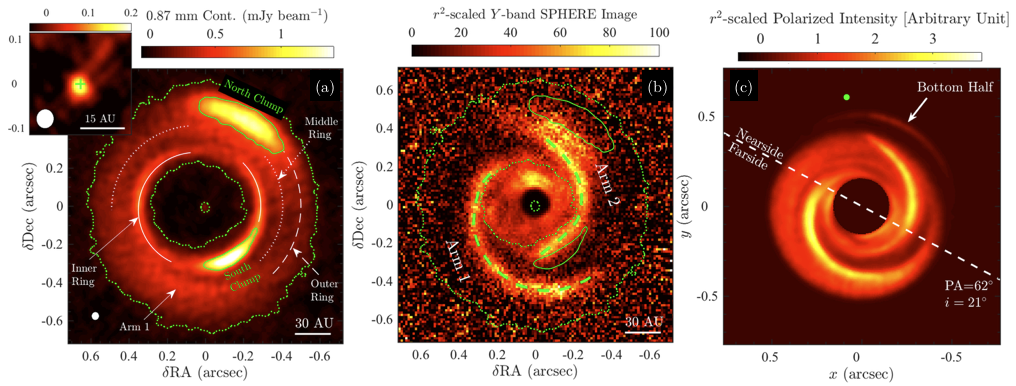Spatially resolved structures in protoplanetary disks hint at unseen planets. Previous imaging observations of the transitional disk around MWC 758 revealed an inner cavity, a ring-like outer disk, emission clumps, and spiral arms, all possibly generated by companions. We present ALMA dust continuum observations of MWC 758 at 0.87 mm wavelength with 43 × 39 mas angular resolution (6.9 × 6.2 au) and 20 μJy beam−1 rms. The central submillimeter emission cavity is revealed to be eccentric; once deprojected, its outer edge can be well fitted by an ellipse with an eccentricity of 0.1 and one focus on the star. The broad ring-like outer disk is resolved into three narrow rings with two gaps in between. The outer two rings tentatively show the same eccentricity and orientation as the innermost ring bounding the inner cavity. The two previously known dust emission clumps are resolved in both the radial and azimuthal directions, with radial widths equal to ~4× the local scale height. Only one of the two spiral arms previously imaged in near-infrared (NIR) scattered light is revealed in ALMA dust emission, at a slightly larger stellocentric distance owing to projection effects. We also submit evidence of disk truncation at ~100 au based on comparing NIR imaging observations with models. The spirals, the north clump, and the truncated disk edge are all broadly consistent with the presence of one companion exterior to the spirals at roughly 100 au.

Panel (a): ALMA 0.87 mm continuum emission from MWC 758 with a beam size 43 × 39 mas (6.9 × 6.2 au; labeled at the lower left corner). North is up and east is to the left. The structures are labeled: the green dotted contours are at the 3σ noise level; the two green solid contours are at half-peak intensity at each clump; the solid, dotted, and dashed white arcs trace the inner, middle, and outer rings, respectively; and the inset is a 0″.2 zoom of the central region (stellar location marked by the green plus).
Panel (b) shows an r2-scaled SPHERE Y-band (1 μm) polarized scattered-light image (Benisty et al. 2015; normalized unit). The contours in panel (a) are overlaid, and the two green dashed lines trace the locus of the two spiral arms (labeled as Arm 1 and Arm 2). The astrometrical alignment between the SPHERE and ALMA images is done by aligning the location of the central star. The absolute stellar position in the SPHERE image may be accurate to half the SPHERE pixel size (6 mas).
Panel (c) is the HOCHUNK3D-simulated NIR polarized-light image of a disk perturbed by a planet. The simulation is based on Dong et al. (2015b), in which the planet mass is six-thousandth of the stellar mass and is located at 100 au. The disk is truncated at 80 au (i.e., roughly at the inner edge of the gap opened by the planet). The synthetic observation is produced using the geometry of MWC 758 (Isella et al. 2010; Boehler et al. 2018): the southeast side is the far side, inclination i = 21°, and position angle PA = 62° (major axis marked by the dashed line). The green dot marks the projected location of the planet.

